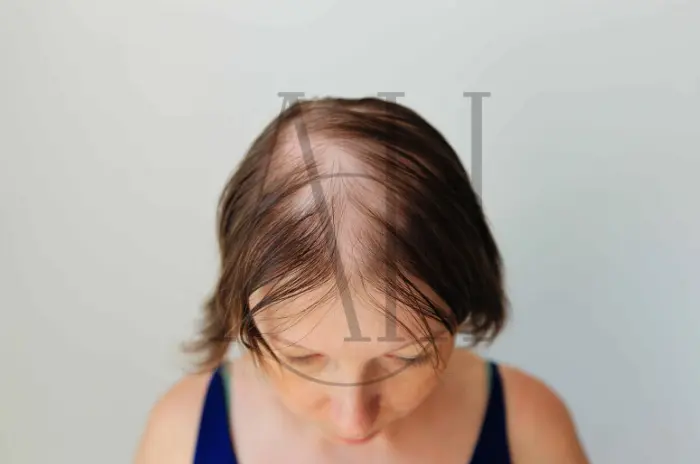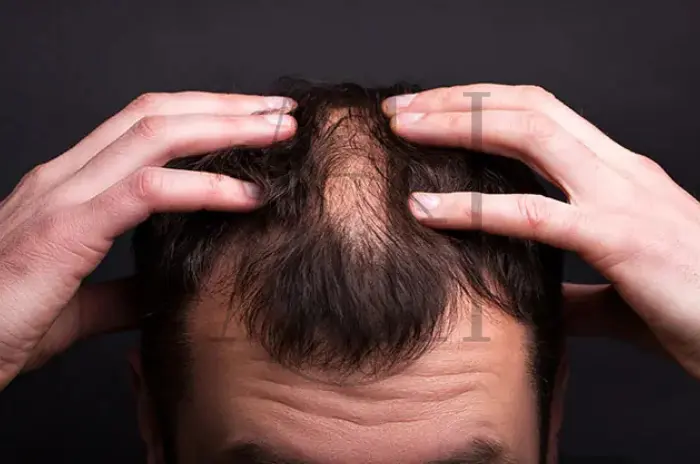Diffuse thinning represents one of the most common forms of hair loss affecting millions worldwide. Unlike localized balding patterns, this condition causes uniform hair thinning across the entire scalp, making hair appear less dense and revealing increased scalp visibility. The gradual nature of diffuse thinning often means people don’t notice the problem until significant volume has been lost.
Understanding the causes, recognizing early signs, and knowing which treatments work can make the difference between progressive hair loss and successful restoration. This comprehensive guide explores the symptoms, causes, and proven treatments for diffuse thinning, helping you take control of your hair health.
Table of Contents
ToggleWhat diffuse thinning is and common signs
Diffuse thinning is a pattern of hair loss where hair density decreases uniformly across the entire scalp rather than in specific areas. This condition differs from male pattern baldness or alopecia areata, which create distinct bald patches. With diffuse thinning, every area of the scalp experiences proportional hair reduction without creating completely bald spots.
The condition affects both men and women, though presentation may vary. In women, diffuse thinning often manifests as widening parts and reduced ponytail thickness while maintaining the frontal hairline. Men may experience overall volume loss in addition to typical pattern baldness.
Common signs include increased scalp visibility under normal lighting, especially when hair is wet or styled. Your scalp becomes progressively more visible because fewer hair shafts occupy each area. Excessive hair shedding represents another hallmark sign. While normal hair loss ranges from 50-100 strands daily, people with diffuse thinning may lose significantly more.
Changes in hair texture often accompany diffuse thinning. Individual strands become finer, weaker, and more prone to breakage. Your hair may feel less substantial, and styling becomes difficult as volume decreases. Other signs include a wider part line, decreased overall volume, reduced ponytail circumference, and needing more products to achieve fullness.
How to Spot Symptoms of Diffuse Hair Loss
Early detection of diffuse hair loss symptoms enables prompt intervention and better outcomes. Begin by monitoring your daily hair fall patterns. Collect the hair that sheds during your morning routine for several days. If you consistently notice more than 100-150 strands daily, this may indicate diffuse thinning.
Photographic documentation provides valuable evidence of hair thinning progression. Take consistent photos of your scalp from multiple angles in similar lighting monthly. Compare these images over time to identify whether scalp visibility is increasing or hair density is decreasing.
The “pull test” offers a simple home assessment. Grasp approximately 60 strands of hair between your fingers, then pull gently but firmly. If more than 6-8 hairs come out, this may indicate active diffuse hair loss. Perform this test in multiple scalp areas.
Visual examination in bright lighting reveals increasing scalp visibility. Stand under bright lighting and part your hair in multiple directions. Compare how much scalp shows through compared to previous years or old photographs. Increased visibility, especially at the part line and crown, suggests progressive diffuse thinning.
Watch for changes in hair growth patterns. Notice whether your hair stays the same length for extended periods or fails to grow as long as previously. Reduced growth rate combined with increased shedding indicates follicles may be spending less time in the active growth phase.
If you observe multiple symptoms persisting for more than three months, consulting a hair loss specialist becomes important. Professional evaluation can distinguish diffuse thinning from other conditions and identify underlying hair loss causes.
Main causes of diffuse thinning including telogen effluvium
Understanding hair loss causes is essential for effective treatment of diffuse thinning. Multiple factors can trigger this condition, and identifying the specific cause determines the appropriate therapeutic approach.
Telogen effluvium represents the most common cause of diffuse thinning. This condition occurs when significant numbers of hair follicles prematurely enter the telogen (resting) phase. Normally, about 10-15% of follicles rest at any time, but telogen effluvium can push 30-50% into this phase simultaneously. These resting hairs shed 2-3 months after the triggering event, creating noticeable hair fall.
Common triggers include severe stress, major surgery, high fever, significant weight loss, childbirth, and certain medications. The delayed onset between trigger and shedding often makes identifying the exact cause challenging.
Androgenetic alopecia, also known as male pattern baldness or female pattern hair loss, can present as diffuse thinning particularly in women. This hereditary condition involves progressive follicle miniaturization due to DHT sensitivity. While men develop distinct recession patterns, women often experience diffuse thinning across the crown.
Nutritional deficiencies frequently contribute to diffuse hair loss. Iron deficiency, particularly low ferritin levels, is strongly associated with hair thinning especially in women. Protein malnutrition, zinc, biotin, vitamin D, and B vitamin deficiencies also impair healthy hair growth.
Thyroid disorders commonly cause diffuse thinning. Both hypothyroidism and hyperthyroidism can disrupt the hair growth cycle. Treating the underlying thyroid condition usually restores normal hair growth over time.

Top Treatments for Diffuse Thinning Recovery
Effective hair loss treatment for diffuse thinning requires a comprehensive approach addressing underlying causes while supporting hair regrowth.
Minoxidil for hair loss stands as the first-line topical treatment. This FDA-approved medication, available in 2% and 5% concentrations, prolongs the growth phase and stimulates follicles. Applied twice daily to the scalp, minoxidil demonstrates effectiveness for both men and women. Initial results appear after 3-4 months, with maximum benefit around 12 months.
Finasteride for hair loss is an oral medication that inhibits DHT conversion, reducing follicular miniaturization. Prescribed primarily for men with androgenetic alopecia, the standard dose is 1mg daily. Results become apparent after 3-6 months. Women of childbearing potential should not use finasteride due to birth defect risks.
Addressing nutritional deficiencies represents a critical treatment component. Iron supplementation under medical supervision benefits those with confirmed deficiency. Other beneficial supplements include biotin, zinc, vitamin D, and B-complex vitamins.
For telogen effluvium, the primary treatment involves identifying and removing the triggering factor. This may include managing stress, adjusting medications, treating thyroid disorders, or improving nutrition. Most cases resolve within 6-12 months after addressing the trigger.
Hair growth shampoo containing active ingredients supports treatment effectiveness. Ketoconazole shampoo possesses anti-inflammatory and anti-androgenic properties. Caffeine-containing shampoos may stimulate follicles. These products work best as adjuncts to medical treatments.
Low-level laser therapy (LLLT) uses red light wavelengths to stimulate cellular activity. FDA-cleared devices are available for home use. Treatment protocols typically require sessions 3-4 times weekly. Studies demonstrate modest improvements with consistent use.
How to identify diffuse thinning early
Early identification of diffuse thinning significantly improves treatment outcomes by enabling prompt intervention. Establish a baseline assessment of your current hair status. Take detailed photographs from multiple angles under consistent lighting. Note your ponytail circumference and document family history of hair loss.
Implement monthly self-examinations focusing on key indicators. Check your part line width under bright lighting. Assess overall volume by gathering hair into a ponytail, noting whether it feels smaller. Examine your hairline for any subtle recession or thinning.
Monitor daily shedding patterns consistently. Count hairs lost during specific activities for one week each month. Establish your normal baseline, then watch for sustained increases. Remember that temporary increases during seasonal changes are normal, but persistent elevation beyond 3 months warrants attention.
Watch for texture changes that often precede visible thinning. Notice whether individual strands feel finer or more fragile. Check if your hair tangles more easily or breaks more frequently during styling.
Be alert to potential triggering events. Major life stresses, significant weight changes, new medications, medical procedures, or hormonal fluctuations may trigger telogen effluvium. Recognizing these triggers helps identify the cause if hair loss develops 2-3 months later.
If you notice consistent changes persisting beyond three months, schedule an appointment with a hair loss specialist. Early professional evaluation can distinguish normal shedding from pathological diffuse thinning.
Diffuse thinning vs pattern hair loss key differences
Understanding distinctions between diffuse thinning and pattern hair loss is crucial for accurate diagnosis and appropriate treatment selection.
Diffuse thinning affects the entire scalp uniformly without creating distinct patterns. Hair density decreases proportionally across all areas. The hairline typically remains intact or recedes uniformly. Scalp visibility increases gradually throughout the head, but complete baldness in specific zones rarely occurs.
Male pattern baldness follows predictable patterns. Hair loss begins with temporal recession creating an M-shaped hairline, followed by crown thinning. These areas progressively expand and may merge, leaving a horseshoe pattern. The progression is distinctly non-uniform.
Female pattern hair loss usually presents as diffuse thinning concentrated at the crown while preserving the frontal hairline. The part line widens and the crown shows progressive scalp visibility.
| Feature | Diffuse Thinning | Pattern Hair Loss |
|---|---|---|
| Distribution | Uniform across scalp | Specific zones |
| Hairline | Maintained | M-shaped recession |
| Sides/Back | Affected proportionally | Usually preserved |
| Primary Cause | Various triggers | Genetic DHT sensitivity |
| Reversibility | Often reversible | Permanent without treatment |
The underlying causes differ substantially. Pattern hair loss results from genetic predisposition and DHT sensitivity. Diffuse thinning can stem from telogen effluvium, nutritional deficiencies, hormonal imbalances, or stress. Many cases are temporary and reversible when the trigger is addressed.
Treatment approaches show both overlap and distinction. Both conditions benefit from minoxidil for hair loss. Finasteride for hair loss specifically targets DHT-mediated androgenetic alopecia. Diffuse thinning treatment emphasizes identifying and addressing underlying causes.
Diffuse Thinning Causes Symptoms and Treatment Options – Frequently Asked Questions
What are the common signs of diffuse thinning?
Common signs include uniform hair density loss across the entire scalp, increased scalp visibility, excessive daily shedding beyond 100 strands, finer hair texture, wider part line, and reduced ponytail thickness.
How does diffuse thinning differ from pattern hair loss?
Diffuse thinning affects the entire scalp uniformly without distinct patterns, while pattern hair loss creates specific recession zones at temples and crown with preserved sides and back.
What are the main causes of diffuse thinning?
Main causes include telogen effluvium from stress or illness, androgenetic alopecia, nutritional deficiencies especially iron, thyroid disorders, medications, hormonal changes, and chronic medical conditions.
What are the most effective treatments for diffuse thinning?
Most effective treatments include minoxidil topical solution, addressing underlying nutritional deficiencies and medical conditions, finasteride for androgenetic cases, stress management, and proper hair care practices under specialist guidance.




